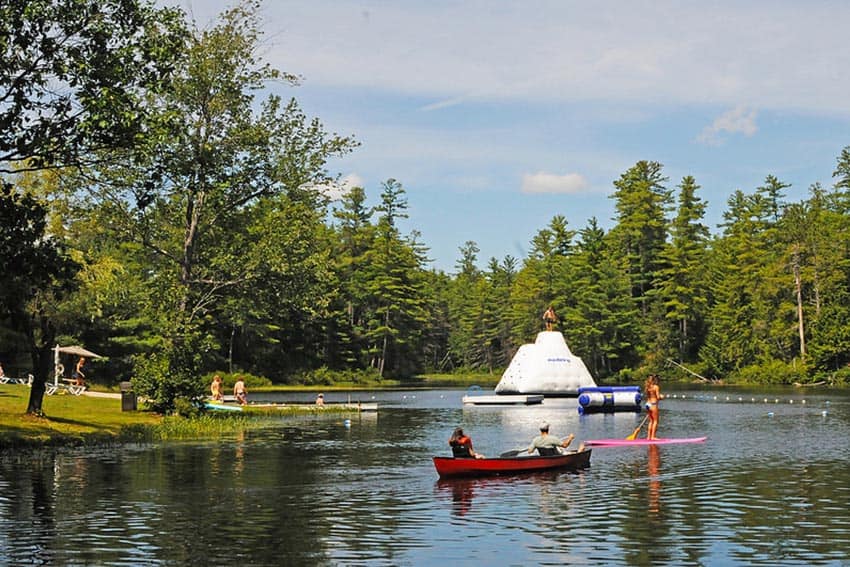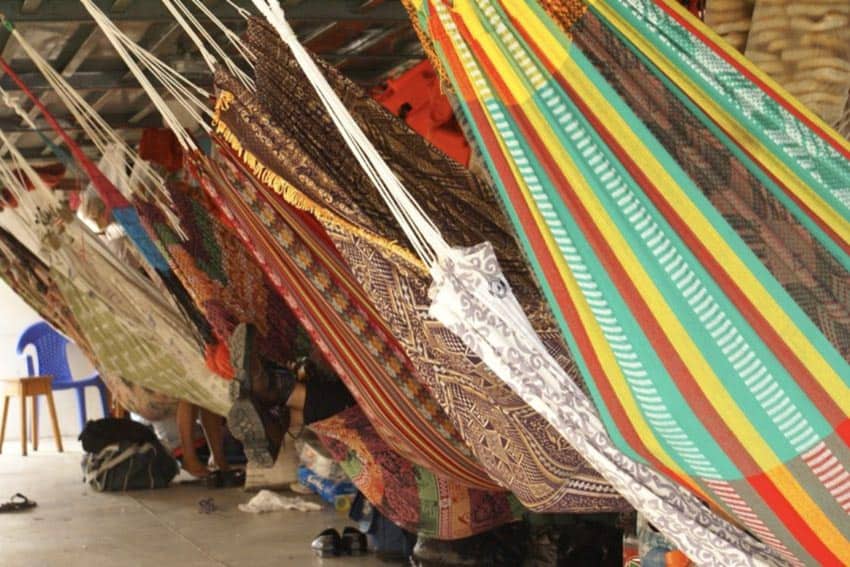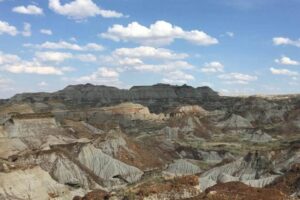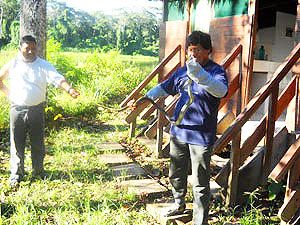
A Family Amazon Trip to Peru’s Manu National Park
By Michael Space
‘Whump! Thwack, thwack, thwack, thwack!’
I was half undressed in the tiny bathroom when I heard the crash onto the shower stall floor. A long black tail whipped furiously from beneath the shower curtain. The snake was big.
“Oh, crap,” I whispered. I hurriedly put my clothes back on while the snake pounded against the tile behind the curtain. Suddenly, the seriously pissed off seven-foot-long snake burst through the stall and stopped between me and the door. It wavered back and forth, its head at waist level, mouth open. And then it struck.
Welcome to the Amazon
It started innocently enough nine months ago at the family dinner table. I had read about Manu National Park, a large swath of pristine rainforest in southern Peru that was reportedly full of wildlife. I deftly steered the conversation toward our next vacation and mentioned the Peruvian Amazon.
“Cool!” said my sons Clay (12) and Cole (10). I smiled and glanced at my wife.
“Hmm, wouldn‘t our money be better spent on re-landscaping the front yard?” she asked.
Her answer was not an explicit ‘no’, and that was as good as a ‘yes’ to me. So, off we went. It was June 2009 when the four of us boarded a van in Cusco operated by Manu Nature Tours. We opted for the 5 night/6 day Manu tour. Our primary guide was Wilfredo Arizabal, a Peruvian herpetologist (reptile and amphibian expert). A young Dutch couple shared the van with us.
A Long Journey

Our first day was a nine-hour drive over a nearly 14,000-foot Andean pass, then a descent into the Manu National Park cloud forest.
This is a peculiar high-elevation ecosystem unique to the tropics where precipitation comes primarily in the form of clouds, or fog, that drape the landscape.
We were fortunate that it was a rare clear day and saw many birds such as the Andean Cock-of-the-Rock (Peru‘s national bird), as well as a set of puma tracks.
We slept that night at the comfortable Manu Cloudforest Lodge before continuing to the Amazon rainforest. We drove for an hour along dirt roads, descending several thousand feet before reaching our take-in point on the Madre de Dios (Mother of God) River, an Amazon River tributary.
We boarded a streamlined canopied wooden boat equipped with a 60 hp motor for an eight-hour boat ride up the Madre de Dios and then up the Manu River.

Monkey-Hands
We stopped along the way for Manu Preserve permits (get the cool T-Shirts) and to refuel at Boca Manu, a small village near the confluence of the Manu River with the Madre de Dios.
At Boca Manu, we climbed up the riverbank into a clearing surrounded by jungle. We walked past gobbling turkeys, lazy dogs, and curious giggling schoolchildren peeking around a corner, toward a small store to buy a soda.
We were greeted by a lady and her capuchin monkey. The monkey hopped onto the counter and walked toward us while the lady held his tail. His eyes were a mixture of fear and intense curiosity, and its fur felt very soft.
The monkey’s hands were eerily similar to our own, complete with fingernails instead of claws. My wife was ‘ooohing’ and ‘awwing’ just a little too much, and I thought it best to get out of there before we ended up with an extra passenger in the boat.
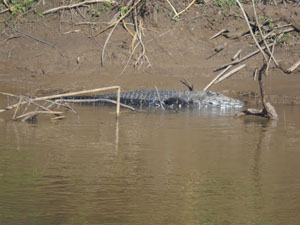
Three Million Acres of Pristine Rainforest
As we boated up the Manu River the country got wilder and the wildlife more diverse. Thatched huts gave way to forest. Storks, herons, terns, vultures, and turtles became commonplace.
And soon we observed speckled and black caimans sunning themselves in shallow water and on the sandbanks. The black caimans can get quite large and we got close to a 15-foot specimen.
“What would happen if I stepped into the water?” I asked.
My sons looked at me with a ‘Duh’ expression. “Look at the teeth, Dad.”
What I was really looking for were the large mammals that can often be seen here, such as capybaras, deer, tapirs, and the large cats such as the elusive jaguar, puma, jaguarundi, and ocelot.
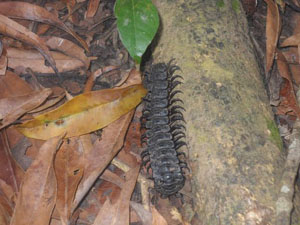
We motored up the river, the wind cool enough for us to don jackets.
The trees were dense and tall, right up to the river’s edge. The only open areas were the sandbars where the caimans sunned and the storks and herons walked warily.
The sandbars, exposed during the dry season were also where one could see the big mammals enjoying the sun. We had no luck with mammals that day except for a capybara and red howler monkeys.
We reached our dock at dark and slipped on our packs on for the nearly ½ mile walk to the lodge.
Amazon Ants!
My sons turned on their flashlights and we walked along the jungle path, trees soaring into the darkness above us, listening to the night sounds; crickets, frogs, night monkeys, and birds. Although it was the dry season, Wilfredo said they had three days of steady rain before we arrived, drawing out the mosquitoes. We slipped and stumbled through the dark, the mud pulling on our shoes with each step.
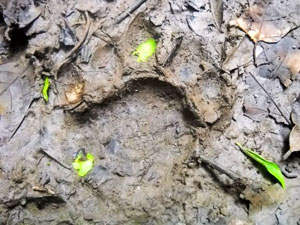
As we came within sight of the lodge, I felt stinging, sharp bites on my legs. At first, I thought it was my imagination, but as we entered the lodge foyer everyone else in our party was hopping up and down.
“Ants!” The Dutch lady screamed and slapped her legs and stomped her feet, and soon we were all doing the same in some kind of badly choreographed jig.
Fauna and Flora Smorgasbord
After dancing with the ants and stomping them to death for several minutes we made it inside to a hearty meal and pisco sours (the Peruvian national drink). The night was surprisingly cool and we slept well.
After breakfast the next morning we took a long walk into the rainforest. The forest was full of sounds; birds, and grasshoppers and other insects, which at times would be usurped by a larger noise, such as the flapping of king vulture wings, spider monkeys slashing their way through the treetops, red and yellow macaws calling over the canopy.

Manu National Park is one of the most biodiverse areas on the planet, with more than 1,000 bird species, 15,000 plant species, 200 mammal species, and over a million insect species.
Over the next two days we saw lots of exotic creatures; bright yellow spiders, light green nearly translucent frogs, false coral and false pit viper snakes, lots of birds, four monkey species, and giant river otters.
And the plant life was amazing too, with strangler figs that slowly choke their tree host, and wandering palm trees that can “migrate” to sunlight.
Deeper within Manu National Park, off limits to tourists, are aboriginal tribes that have no contact with outside civilization. Reportedly, about ten years ago an anthropologist that insisted on tracking one tribe was welcomed with an arrow to his shoulder and barely escaped with his life.
But I wanted to see one of the big cats or a tapir. Alas, no luck there. Tapirs are primitive-looking animals that bear a strong resemblance to miniature elephants.

We saw some tapir tracks, as well as jaguar tracks. The jaguar tracks were bigger than my hand, and there were territorial scratches on several trees higher than I could reach.
Trapeze Artists and Smelly Birds
Each day after a mid-afternoon siesta, we would explore again until dark. One late afternoon we took a ride on a catamaran around the oxbow lake.
We swatted sand flies and mosquitoes as the two guides paddled away from the dock, one using a coal shovel as an improvised paddle. As we slowly moved along the shore, I heard what sounded like a cough.
“Hoatzins,” Wilfredo said. Hoatzins are common birds in the Amazon because they taste so bad predators will target them only as a last resort.
The guides stopped paddling and we listened. The bushes along the lake rustled from wings beating against the branches and leaves, the birds seemingly just beyond our sight. Then, out of nowhere, a troop of large black spider monkeys swung through the upper canopy from tree to tree, 100 feet off the ground. Within seconds all the lakeside bushes and trees bristled with life.
Monkey Jumps
A troop of dozens of reddish-brown capuchin monkeys jumped and flew through the middle canopy. Below them, about a hundred tan squirrel monkeys scurried and leaped through the lower canopy. We had front row seats to this aerial display.

The spectacle lasted about fifteen minutes, with the squirrel and capuchin monkeys often peeking at us from the brush as they fed on small fruits.
The spider monkeys were more reclusive but were still spotted when they climbed the vines or sprung from tree to tree.
Even the hoatzins got in the act, as if jealous we were no longer paying attention to them, and about ten sat out in the open on a large bush. Our guides were laughing and gawking at the monkeys as much as we were.
“Although these species often travel together, it is very rare for people to see them like this,” Wilfredo told us later.
Night fell and a full moon rose over the oxbow lake. The stars appeared, and we spent time listening to frogs and crickets and staring up at the sky at the constellations unique to the Southern Hemisphere, such as the Southern Cross (the vertical part of the cross points due south), before heading back to the lodge.
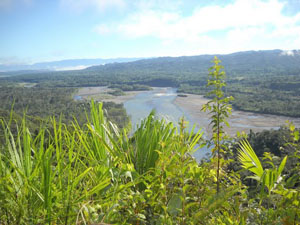
A Vicious, Harmless Snake
But nothing got my adrenalin going like that snake. I jumped out of the way of its first strike. It continued to writhe around the floor, head quivering, staring at me.
It struck again. I jumped to the side and felt its head slide along my pants. At that moment, the exit was clear and I burst through that door and slammed it behind me.
A thousand thoughts went through my brain. ‘Was that a black mamba? No, wrong continent. Did I just scream like a little schoolgirl? Maybe. Did it bite me? Was it venomous?’
I checked my legs for a snake bite. Nothing. The grounds were empty. I stood there for a minute trying to clear my head. Eventually, I found Wilfredo, who calmly stepped into the bathroom and remerged, snake in hand.
He had it gripped just behind the head as it wrapped itself around his arm and neck. “Whiptail snake,” he said, and then added while grinning at me. “Not poisonous. It must have fallen through a hole in the thatched roof.”
I learned that as a general rule in the Amazon, non-venomous snakes are diurnal (active during the day), while venomous snakes like the deadly fer-de-lance, Bushmaster, and coral snakes, come out at night.
A Few Recommendations
As we boarded the boat the next day for our long ride to Puerto Maldonado, I wished we had planned a few more days there. If you go, which I highly recommend, remember:
- Bring the right attitude. Be flexible. Peruvian time schedules and driving laws are made to be broken. This is a remote area. Machines break, and the weather doesn’t always cooperate.
- Bring the kids! They’re probably more resilient than you.
- Insects rule. Bring lots of insect repellent and expect it not to work. Tuck your pants into your socks so the ants have to feast on someone else in your group, like the old Bavarian couple in shorts.
- Take your showers during the day. Trust me on this.
Contact information:
www.manuperu.com ; Boris Gomez Luna, owner
email at info@manunaturetours.com .
See Michael Space’s videos of Manu National Park
 Michael Space is an environmental scientist who enjoys traveling to new places and sharing his experiences with other families interested in adventure travel.
Michael Space is an environmental scientist who enjoys traveling to new places and sharing his experiences with other families interested in adventure travel.
- These 9 U.S. National Parks Require Reservations in 2024 - April 17, 2024
- Take a Hike in Olympic National Park - April 17, 2024
- The Wild Mississippi: 2340 Miles Across Ten States - April 8, 2024


